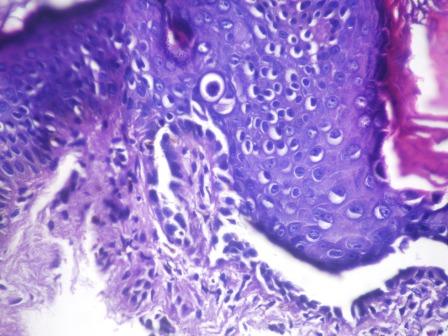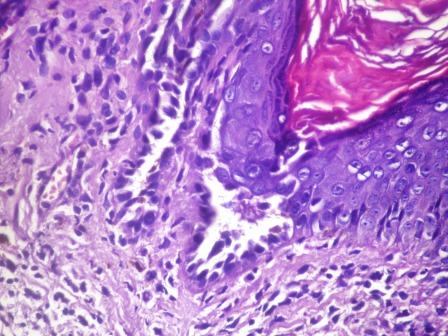19 August 2009 - Case #155
All cases are archived on our website. To view them sorted by case number, diagnosis or category, visit our main Case of the Month page. To subscribe or unsubscribe to Case of the Month or our other email lists, click here.
This case was contributed by Dr. Asmaa Gaber Abdou, Menofiya University, Egypt.
Case #155
Clinical history:
An 18 year old girl suffered from closely packed dark papules on her feet and legs since she was 6 years old. She now presented with new papules on her hands, extending to her arms. The papules were biopsied.
Microscopic images:
What is your diagnosis?
Diagnosis: Darier disease (Darier-White disease, keratosis follicularis)
Discussion:
Histologic examination of the papules revealed mild acanthotic epidermis with slight papillomatosis, hyperkeratosis and follicular plugging. Scattered dyskeratotic cells were present in the spinous layer. Cells displayed basophilic cytoplasm and round, pyknotic nuclei surrounded by clear halos (corp ronds) or elongated grain shaped nuclei (grains), a characteristic of Darier disease.
Darier disease is an autosomal dominant condition of the skin, nails and mucosal surfaces. It is caused by mutations in the ATP2A2 gene, encoding sarcoendoplasmic reticulum calcium pumping ATPase type 2 (SERCA2), which cause loss of adhesion between epidermal cells and abnormal keratinization (Cell Mol Life Sci 2008;65:205). Patients usually present during their teenage years with dark, crusty, keratotic papules, sometimes filled with pus or accompanied by a strong, lingering odor. Lesions are exacerbated by heat and UV light. There is often no family history (J Eur Acad Dermatol Venereol 2005;19:114).
Treatment has limited success and consists of topical and systemic retinoids. For acute flares, topical corticosteroids, cyclosporin and antibiotics have been used (Am J Clin Dermatol 2003;4:97).
The differential diagnosis includes:
References: eMedicine: Keratosis Follicularis (Darier Disease) [Accessed 29 April 2024], Wikipedia: Darier's Disease [Accessed 29 April 2024], J R Soc Med 2003;96:439, Elder: Lever's Histopathology of the Skin, 10th Edition, 2008
All cases are archived on our website. To view them sorted by case number, diagnosis or category, visit our main Case of the Month page. To subscribe or unsubscribe to Case of the Month or our other email lists, click here.
This case was contributed by Dr. Asmaa Gaber Abdou, Menofiya University, Egypt.
Website news:
(1) If you have a Flickr account, you can upload gross, microscopic or other images directly to our Flickr group at http://www.flickr.com/groups/pathologyoutlines/. We will post a link to these images in the appropriate chapter of our online textbook, so pathologists and related personnel throughout the world can benefit from them. We will also list you as a contributor in our various news messages.
(2) We have updated the Smooth Muscle and Skeletal muscle sections of our Soft Tissue Tumors - Part 3 chapter, and are currently updating the Breast-malignant chapter.
Visit and follow our Blog to see recent updates to the website.
(1) If you have a Flickr account, you can upload gross, microscopic or other images directly to our Flickr group at http://www.flickr.com/groups/pathologyoutlines/. We will post a link to these images in the appropriate chapter of our online textbook, so pathologists and related personnel throughout the world can benefit from them. We will also list you as a contributor in our various news messages.
(2) We have updated the Smooth Muscle and Skeletal muscle sections of our Soft Tissue Tumors - Part 3 chapter, and are currently updating the Breast-malignant chapter.
Visit and follow our Blog to see recent updates to the website.
Case #155
Clinical history:
An 18 year old girl suffered from closely packed dark papules on her feet and legs since she was 6 years old. She now presented with new papules on her hands, extending to her arms. The papules were biopsied.
Microscopic images:
What is your diagnosis?
Click here for diagnosis and discussion:
Diagnosis: Darier disease (Darier-White disease, keratosis follicularis)
Discussion:
Histologic examination of the papules revealed mild acanthotic epidermis with slight papillomatosis, hyperkeratosis and follicular plugging. Scattered dyskeratotic cells were present in the spinous layer. Cells displayed basophilic cytoplasm and round, pyknotic nuclei surrounded by clear halos (corp ronds) or elongated grain shaped nuclei (grains), a characteristic of Darier disease.
Darier disease is an autosomal dominant condition of the skin, nails and mucosal surfaces. It is caused by mutations in the ATP2A2 gene, encoding sarcoendoplasmic reticulum calcium pumping ATPase type 2 (SERCA2), which cause loss of adhesion between epidermal cells and abnormal keratinization (Cell Mol Life Sci 2008;65:205). Patients usually present during their teenage years with dark, crusty, keratotic papules, sometimes filled with pus or accompanied by a strong, lingering odor. Lesions are exacerbated by heat and UV light. There is often no family history (J Eur Acad Dermatol Venereol 2005;19:114).
Treatment has limited success and consists of topical and systemic retinoids. For acute flares, topical corticosteroids, cyclosporin and antibiotics have been used (Am J Clin Dermatol 2003;4:97).
The differential diagnosis includes:
- Acrokeratosis verruciformis: rare autosomal dominant disorder of keratinization; multiple flat, skin colored keratotic wart-like lesions on dorsum of hands and feet; may be related to acral Darier disease but lacks dyskeratotic cells
- Familial benign pemphigus (Hailey-Hailey disease): chronic autosomal dominant disorder with suprabasilar and widespread acantholysis
- Seborrheic dermatitis: papulosquamous disorder of sebum rich areas of scalp, face and trunk; severity varies over time; also associated with Malassezia (a fungus); nonspecific histologic findings
- Transient acantholytic dermatosis (Grover disease): pruritis is common; similar histologic findings of focal acantholysis, dyskeratosis and spongiosis
- Warty dyskeratoma: an isolated follicular lesion
References: eMedicine: Keratosis Follicularis (Darier Disease) [Accessed 29 April 2024], Wikipedia: Darier's Disease [Accessed 29 April 2024], J R Soc Med 2003;96:439, Elder: Lever's Histopathology of the Skin, 10th Edition, 2008




